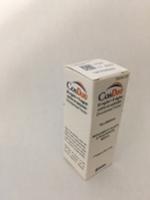

VISUCOPT 20mg/ml + 5mg/ml Eye Drops in Single Dose Containers

Ask a doctor about a prescription for VISUCOPT 20mg/ml + 5mg/ml Eye Drops in Single Dose Containers

How to use VISUCOPT 20mg/ml + 5mg/ml Eye Drops in Single Dose Containers
Introduction
Package Leaflet: Information for the User
Visucopt 20mg/ml + 5mg/ml, eye drops solution in single-dose container(dorzolamida/timolol)
Read the entire package leaflet carefully before starting to use this medication, as it contains important information for you.
- Keep this package leaflet, as you may need to read it again.
- If you have any questions, consult your doctor or pharmacist.
- This medication has been prescribed to you only, and you should not give it to others, even if they have the same symptoms as you, as it may harm them.
- If you experience any type of adverse effect, consult your doctor or pharmacist, even if it is an adverse effect not listed in this package leaflet. See section 4.
Contents of the Package Leaflet
- What Visucopt single-dose is and what it is used for
- What you need to know before starting to use Visucopt single-dose
- How to use Visucopt single-dose
- Possible adverse effects
- Storage of Visucopt single-dose
- Contents of the packaging and additional information
1. What Visucopt single-dose is and what it is used for
Visucopt single-dose contains two active substances: dorzolamida and timolol
- Dorzolamida belongs to a group of medications called "carbonic anhydrase inhibitors".
- Timolol belongs to a group of medications called "beta-blockers".
These medications decrease eye pressure in different ways.
Visucopt single-dose is prescribed to reduce elevated eye pressure in the treatment of glaucoma when the use of a beta-blocker alone is not sufficient.
2. What you need to know before starting to use Visucopt single-dose
- if you are allergic to the active substances (dorzolamida hydrochloride, timolol maleate) or to any of the other components of this medication (listed in section 6)
- if you have or have had respiratory problems such as asthma or severe chronic obstructive bronchitis (a severe lung disease that can cause wheezing, difficulty breathing, or prolonged coughing)
- if you have a low heart rate, heart failure, or heart rhythm disorders (irregular heart rate)
- if you have severe kidney problems or severe renal failure, or a history of kidney stones
- if you have excessive blood acidity caused by the accumulation of chloride (hyperchloremic acidosis)
Warnings and Precautions
Consult your doctor or pharmacist before starting to use Visucopt single-dose if you have or have had:
- cardiovascular diseases/coronary heart disease (symptoms may include chest pain or tightness, difficulty breathing, or shortness of breath), heart failure, low blood pressure; heart rate anomalies, such as low heart rate
- respiratory problems, asthma, or chronic obstructive pulmonary disease
- poor blood circulation (such as Raynaud's disease or Raynaud's syndrome)
- diabetes, as timolol, one of the active substances of Visucopt, may mask the signs and symptoms of hypoglycemia
- hyperthyroidism, as timolol may mask the signs and symptoms of this disorder
Tell your doctor:
- if you are using Visucopt single-dose and need to undergo surgery, as timolol may alter the effects of some medications used during anesthesia
- if you have been diagnosed with severe myasthenia (muscle weakness)
- if you experience eye irritation or new eye problems such as eye redness or eyelid swelling, contact your doctor immediately
- if you experience an eye infection, suffer an eye injury, undergo eye surgery, or experience other reactions, such as the appearance of new symptoms or the worsening of pre-existing symptoms.
The instillation of Visucopt single-dose in the eye can affect the entire body.
Use in Children and Adolescents
Experience with Visucopt single-dose in infants and children is limited.
Use in Elderly Patients
In studies conducted with dorzolamida/timolol, the effects of the combination of the two active substances were similar in elderly patients and in younger patients.
Use in Patients with Hepatic Impairment (Liver Failure)
Tell your doctor about any liver problems you have or have had in the past.
Doping Tests
The use of this medication may produce positive results in doping tests.
Other Medications and Visucopt Single-Dose
Tell your doctor or pharmacist if you are using, have recently used, or may need to use any other medication, including those purchased without a prescription.
Visucopt single-dose may affect or be affected by other medications you are using, including other eye drops for the treatment of glaucoma.
Tell your doctor if you are using or plan to use medications to lower blood pressure, to treat heart diseases (cardiopathies), or to treat diabetes.
Tell your doctor:
- if you are taking medications to lower blood pressure or to treat heart diseases (such as calcium antagonists, beta-blockers, or digoxin).
- if you are taking medications to treat heart disorders or heart rate anomalies (such as calcium antagonists, beta-blockers, or digoxin).
- if you are using another eye drop that contains an active substance belonging to the class of "beta-blockers", ask your doctor for more information.
- if you are taking another medication for ocular hypertension (carbonic anhydrase inhibitor, such as acetazolamide).
- if you are taking medications called "monoamine oxidase inhibitors (MAOIs)" used to treat depression.
- if you are taking a medication belonging to the class of "parasympathomimetics" that you have been prescribed to help you urinate. Parasympathomimetics are also a specific type of medication sometimes used to help normalize bowel movements.
- if you are taking "narcotics" such as morphine, used to treat severe pain.
- if you are taking medications to treat diabetes.
- if you are taking known antidepressants, such as fluoxetine and paroxetine.
- if you are taking "sulfonamides".
- if you are taking "quinidine", which is used to treat heart conditions and some types of malaria.
Pregnancy and Breastfeeding
If you are pregnant or breastfeeding, think you may be pregnant, or plan to become pregnant, consult your doctor or pharmacist before using this medication.
Use During Pregnancy
Visucopt single-dose should not be used during pregnancy.
Use During Breastfeeding
Do not use Visucopt single-dose if you are breastfeeding. Timolol may pass into breast milk.
Driving and Using Machines
The influence of Visucopt single-dose on the ability to drive and use machines is small. However, there are adverse effects associated with the use of Visucopt single-dose, such as transient blurred vision, which may affect your ability to drive or use machines. Do not drive or use machines until you feel well or until your vision has cleared.
3. How to Use Visucopt Single-Dose
Follow the administration instructions of this medication exactly as indicated by your doctor or pharmacist. In case of doubt, consult your doctor or pharmacist again. Your doctor will determine the correct dose and duration of treatment.
The recommended dose is one drop of Visucopt single-dose in the affected eye(s) in the morning and at night.
If you are using Visucopt single-dose with other eye drops, they should be instilled with at least a 10-minute difference.
Do not change the dose of the medication without consulting your doctor.
Do not let the cap of the container touch the eye or the surrounding areas. It could become contaminated with bacteria that can cause eye infections that can cause serious damage to the eye, even vision loss. To avoid possible contamination of the container, wash your hands before using this medication and keep the container away from contact with any surface. A new single-dose container should be opened immediately before each use; each container contains a sufficient amount of solution for both eyes if your doctor has told you to use the drops in both eyes.
Instructions for Use
Open the aluminum pouch containing the individual single-dose containers. Note the date of first opening on the pouch.
- Wash your hands and sit or stand in a comfortable position.
- Remove the strip of containers from the pouch.
- Separate a single-dose container from the strip.
- Put the rest of the strip back in the bag and fold the edge to close it.
- To open the container, twist the tab to tear it off.

- Hold the container between your thumb and index finger. Note that the tip of the container should not protrude more than 5 mm above the edge of the index finger.

- Tilt your head back or lie down and look up.
- Gently pull down the lower eyelid to form a pocket between the eyelid and the eye.
- Bring the tip of the single-dose container close to the eye, without touching it.
- Gently press the single-dose container to dispense a single drop into the eye, according to your doctor's instructions. Do not blink while instilling the drop in the eye. Release the lower eyelid.

- Close your eye and press the inner corner of the eye with your finger for about two minutes. This helps prevent the drop from reaching the rest of the body.

- Repeat the process in the other eye if your doctor has instructed you to do so.
- Discard the single-dose container and any remaining contents.
Keep the remaining containers in the aluminum pouch and use them within 7 days of opening the pouch. If there are containers left 7 days after opening the pouch, discard them safely and open a new pouch.
If You Use More Visucopt Single-Dose Than You Should
If you put too many drops in your eye or swallow the contents of the container, you may feel dizzy, have difficulty breathing, or notice a slowing of your heart rate. Contact your doctor immediately.
In case of overdose or accidental ingestion, go to a medical center or call the Toxicology Information Service, phone: 91 562 04 20, indicating the medication and the amount used.
If You Forget to Use Visucopt Single-Dose
It is important that you use Visucopt single-dose as prescribed by your doctor. If you forget a dose, administer it as soon as possible. However, if it is almost time for the next dose, skip the missed dose and continue with the usual dosing schedule. Do not use a double dose to make up for the missed dose.
If You Stop Using Visucopt Single-Dose
If you want to stop using this medication, talk to your doctor first.
If you have any other questions about the use of this medication, ask your doctor or pharmacist.
4. Possible Adverse Effects
Like all medications, this medication can cause adverse effects, although not everyone will experience them.
Timolol is absorbed into the bloodstream, which distributes it throughout the body, similar to other ophthalmic medications.
This can cause adverse effects similar to those observed with medications of the same group (beta-blockers) taken orally. The incidence of adverse effects after ocular administration is lower than with oral administration.
If you experience allergic reactions, such as swelling of the face and limbs with difficulty breathing or swallowing, hives, or itchy rash, localized or generalized rash, itching, or a severe and potentially life-threatening allergic reaction, stop using this medication and consult your doctor immediately.
The following adverse effects have been reported with dorzolamida/timolol eye drops or with one of their components during clinical trials or during post-marketing experience:
Very Common(may affect more than 1 in 10 patients)
-eye burning and stinging
-altered taste
Common(may affect up to 1 in 10 patients)
-headache
-redness inside and around the eyes, tearing, or itching in the eyes, corneal erosion (injury to the layer on the front of the eyeball), eyelid swelling or irritation inside and around the eyes, foreign body sensation in the eye, decreased corneal sensitivity (not noticing something is in the eye and absence of pain), eye pain, dry eye, blurred vision
-sinusitis (feeling of tension or fullness in the nose)
-weakness/fatigue and tiredness.
Uncommon(may affect up to 1 in 100 patients)
-depression
-dizziness, fainting
-inflammation of the iris (a part of the eye), visual disturbances (including refractive changes in some cases due to the withdrawal of treatment with miotics)
-slow heart rate
-difficulty breathing (dyspnea)
-indigestion
-kidney stones
Rare(may affect up to 1 in 1,000 patients)
-allergic reactions such as skin rash, hives, itching, in rare cases swelling of the lips, eyes, and mouth, wheezing, or severe skin reactions (Stevens-Johnson syndrome, toxic epidermal necrolysis)
-sleep disorders, nightmares, memory loss
-cerebral ischemia (decreased blood flow to the brain), increased signs and symptoms of severe myasthenia (muscle disorder), decreased libido, tingling or numbness of the hands or feet
-temporary myopia that may resolve after discontinuing treatment, detachment of the layer under the retina that contains blood vessels after filtration surgery, which can cause visual disturbances due to fluid accumulation, drooping eyelids, double vision, formation of crusts on the eyelids, corneal inflammation (causing visual disturbances), low eye pressure
-ringing in the ears
-changes in heart rate or speed, congestive heart failure (heart disease, with difficulty breathing and swelling of the feet and legs due to fluid accumulation), edema (fluid accumulation), chest pain, myocardial infarction, low blood pressure, excessive contraction of blood vessels (Raynaud's phenomenon), swelling or coldness of the hands and feet, reduced circulation in the arms and legs, leg cramps or pain in the legs when walking (claudication), stroke
-difficulty breathing, worsening of lung function, runny nose or nasal congestion, nosebleeds, constriction of the airways, cough
-throat irritation, dry mouth, diarrhea
-skin inflammation due to contact with certain substances (contact dermatitis), hair loss, skin rash with a silvery-white color (psoriasiform rash)
-systemic lupus erythematosus (an immune disease that can cause inflammation of internal organs)
-Peyronie's disease (which can cause the penis to curve)
Other adverse effects listed are reactions commonly observed with the pharmacological class corresponding to ophthalmic beta-blockers:
Frequency Not Known(cannot be estimated from the available data)
-low blood sugar levels
-heart failure, a type of heart rhythm disorder
-abdominal pain, vomiting
-muscle pain not caused by exercise
-sexual dysfunction
-wheezing
-foreign body sensation in the eye (feeling of having something in the eye)
-strong heartbeats, which can be rapid or irregular (palpitations).
-increased heart rate
-increased blood pressure
Reporting Adverse Effects
If you experience any type of adverse effect, consult your doctor or pharmacist, even if it is a possible adverse effect not listed in this package leaflet. You can also report them directly through the Spanish Pharmacovigilance System for Human Use Medications: www.notificaRAM.es. By reporting adverse effects, you can contribute to providing more information on the safety of this medication.
5. Storage of Visucopt Single-Dose
Keep this medication out of the sight and reach of children.
Store in the original packaging to protect it from light.
Once the aluminum pouch is opened, store below 25°C and use within 7 days; containers that have not been used should be discarded. Single-dose containers should be used immediately after opening; the opened single-dose container with the residual medication should be discarded.
Medications should not be thrown down the drain or into the trash. Deposit the containers and medications you no longer need in the SIGRE Point of the pharmacy. If in doubt, ask your pharmacist how to dispose of the containers and medications you no longer need. This way, you will help protect the environment.
6. Package Contents and Additional Information
- 20 mg of the active ingredient dorzolamida 20 mg (corresponding to 22.26 mg of dorzolamida hydrochloride) and 5 mg of the active ingredient timolol (corresponding to 6.83 mg of timolol maleate).
- The other components are mannitol, sodium citrate, hydroxyethylcellulose, sodium hydroxide, and water for injectable preparations.
Appearance of the Product and Package Contents
Visucopt single-dose is a clear and colorless solution.
Each package contains 6, 12, 18, or 24 aluminum pouches, each of which contains 5 single-dose polyethylene containers with 0.166 ml of solution. Each box contains 30, 60, 90, or 120 single-dose containers.
Only some package sizes may be marketed.
Marketing Authorization HolderVISUfarma S.p.A.
Via Alberto Cadlolo 21-00136 Rome,
Italy
Manufacturer
Genetic S.p.A.,
Contrada Canfora,
84084 Fisciano (SA)
Italy
Date of the Last Revision of this Leaflet: March 2023
Detailed and updated information on this medicinal product is available on the website of the Spanish Agency for Medicines and Health Products (AEMPS) http://www.aemps.gob.es/

How much does VISUCOPT 20mg/ml + 5mg/ml Eye Drops in Single Dose Containers cost in Spain ( 2025)?
The average price of VISUCOPT 20mg/ml + 5mg/ml Eye Drops in Single Dose Containers in November, 2025 is around 12.11 EUR. Prices may vary depending on the region, pharmacy, and whether a prescription is required. Always check with a local pharmacy or online source for the most accurate information.
- Country of registration
- Average pharmacy price12.11 EUR
- Active substance
- Prescription requiredYes
- Manufacturer
- This information is for reference only and does not constitute medical advice. Always consult a licensed doctor before taking any medication. Oladoctor is not responsible for medical decisions based on this content.
- Alternatives to VISUCOPT 20mg/ml + 5mg/ml Eye Drops in Single Dose ContainersDosage form: EYEDROP, 10 mg/ml + 5 mg/mlActive substance: timolol, combinationsManufacturer: Novartis Europharm LimitedPrescription requiredDosage form: EYEDROP, 0.3 mg/ml + 5 mg/mlActive substance: timolol, combinationsManufacturer: Brill Pharma S.L.Prescription requiredDosage form: EYE DROP, 0.3 mg/ml + 5 mg/mlActive substance: timolol, combinationsManufacturer: Laboratorio Stada S.L.Prescription required
Alternatives to VISUCOPT 20mg/ml + 5mg/ml Eye Drops in Single Dose Containers in other countries
The best alternatives with the same active ingredient and therapeutic effect.
Alternative to VISUCOPT 20mg/ml + 5mg/ml Eye Drops in Single Dose Containers in Польща
Alternative to VISUCOPT 20mg/ml + 5mg/ml Eye Drops in Single Dose Containers in Україна
Online doctors for VISUCOPT 20mg/ml + 5mg/ml Eye Drops in Single Dose Containers
Discuss dosage, side effects, interactions, contraindications, and prescription renewal for VISUCOPT 20mg/ml + 5mg/ml Eye Drops in Single Dose Containers – subject to medical assessment and local rules.














